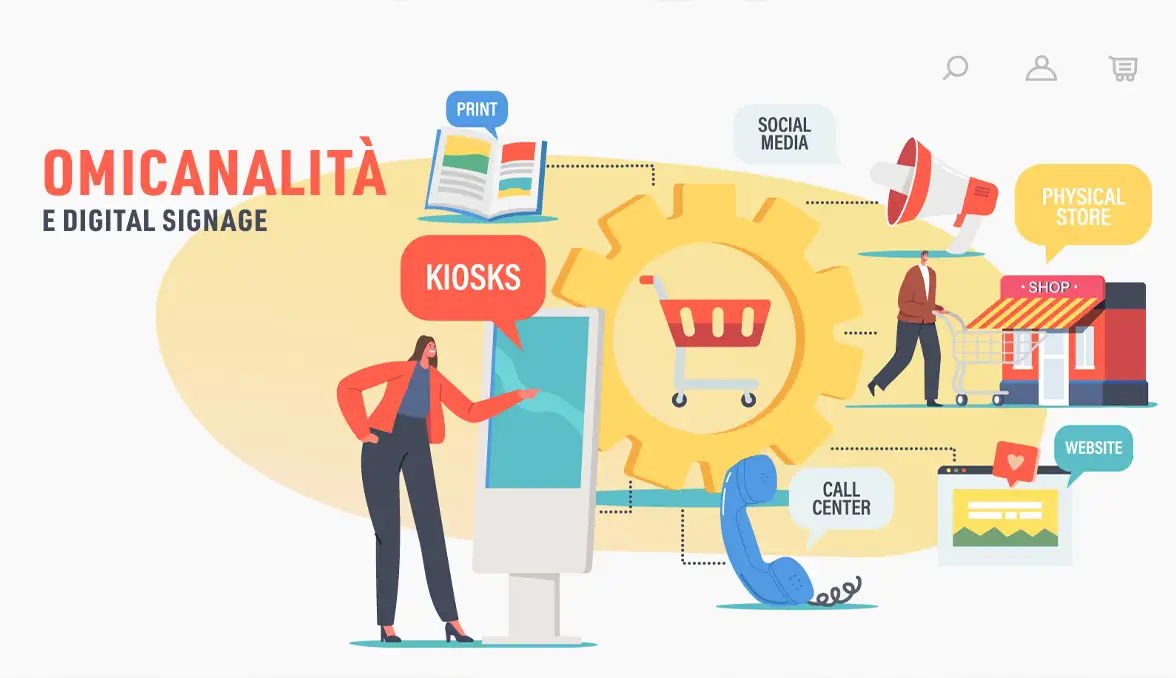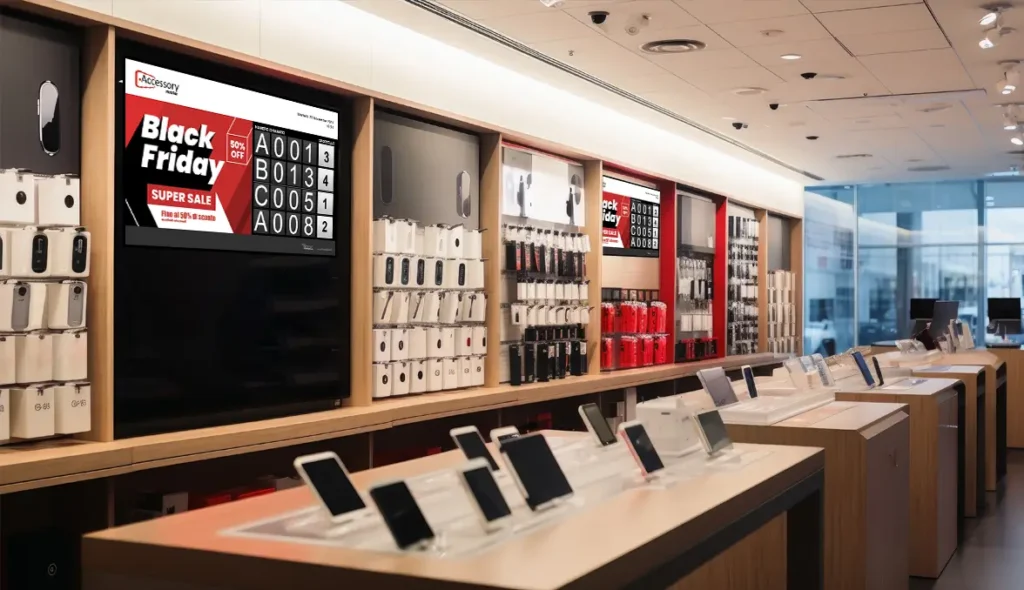In a context where online and offline experiences are increasingly intertwined, an omnichannel strategy becomes crucial for brands that want to meet customer expectations.
Retail digital signage, such as interactive totems, facilitates this integration, offering companies innovative tools to increase in-store conversions.
The Importance of an Omnichannel Strategy in Retail
In retail, continuity between digital and physical channels has become essential to create a seamless and engaging shopping experience. A well-designed omnichannel strategy allows customers to seamlessly transition between online and offline channels, ensuring a consistent and rewarding experience at every touchpoint.
For example, a customer who explores a product on a brand’s website can then visit a store and find the same product, with the same promotions, highlighted on digital displays. This approach not only increases trust in the brand, but also simplifies the decision-making process, reducing any barriers to purchase.
Benefits of Omnichannel for the Customer and the Brand
Adopting an omnichannel strategy is beneficial for both the customer and the brand. For the customer, omnichannel guarantees a personalized experience, where preferences and previous purchases are recognized and valued in every interaction.
For the brand, this strategy allows to obtain valuable data on purchasing behaviors and preferences, providing useful insights to optimize promotions and improve customer satisfaction.
For example, a customer who has added products to the online cart can also receive targeted promotions in-store, thanks to digital signage and data synchronization between different channels.
Digital Signage as a Key Element of Omnichannel
Digital signage plays a crucial role in supporting omnichannel, as it allows brands to offer dynamic and real-time communications in physical stores.
With interactive digital displays, retailers can promote special offers, highlight featured products, or provide personalized information for each customer.
For example, in a fashion store, digital displays can suggest items related to those viewed on the site, inviting the customer to complete the outfit or explore similar collections. This type of approach strengthens the connection between online and offline and makes the shopping experience more engaging and memorable.
The growth of the digital signage market
The global digital signage market is experiencing impressive growth, rising from $26.76 billion in 2023 to a forecast of $52.34 billion by 2032, with a CAGR of 8.1% (source: Analytica Global).
This expansion demonstrates how relevant and growing the role of digital signage is in retail and other sectors. Its ability to make omnichannel visible and immediate is pushing more and more companies to invest in solutions that connect the digital world to the physical one, thus improving the user experience and contributing to concrete results in terms of sales and loyalty.
Digital Signage and Customer Engagement
Beyond product promotion, digital signage can be used to increase customer engagement in innovative ways.
For example, in a retail environment, an interactive display could invite customers to take instant surveys or share their thoughts on the shopping experience, providing immediate feedback to the brand.
This data can then be analyzed to better understand customer preferences and make targeted improvements, fueling a continuous cycle of offering optimization.
An increasingly connected future for retail
The implementation of an omnichannel strategy is now not only a competitive advantage, but a real necessity to meet the expectations of an increasingly demanding and connected clientele.
Brands that adopt these solutions are able to offer a seamless shopping experience, making the transition between the various channels more fluid and natural.
With digital signage, each point of sale becomes an extension of the digital ecosystem, capable of welcoming the customer, personalizing the offer and accompanying them on an intuitive and coherent purchasing path.
How Digital Signage Connects Online and Offline
In retail, digital signage represents a strategic bridge that connects the online world with the physical experience in the store.
Thanks to digital screens positioned in stores, brands can communicate in an immediate and personalized way, offering the customer relevant information that responds to their interests, both online and offline.
This integration makes the shopping experience more consistent and engaging, improving the perception of the brand and supporting the decision-making process .
The contribution for a personalized experience
Digital signage in stores offers the customer a range of dynamic content, including:
- Personalized promotions based on previous online searches, so customers find deals on products they’ve already considered. For example, if a customer has viewed a smartphone on the website, they can find the same item on sale on in-store screens.
- Digital catalogs with real-time availability, which allow you to check the presence of the desired products. This system facilitates the purchasing process and helps customers quickly find what they are looking for.
- Instant feedback on products and services offered, allowing brands to collect opinions directly from customers and adapt the offer in real time, if necessary.
Effects on customer behavior
The effectiveness of digital signage in retail is confirmed by the data: it captures 400% more views than static signage and attracts over 80% of consumers, who declare that they entered the store precisely because of the appeal of visual interactions.
These displays, in fact, do not limit themselves to showing information, but create an involvement that concretely influences purchasing decisions.
Additionally, approximately 40% of customers make unplanned purchases after viewing information on digital screens, demonstrating how digital signage can increase sales through cross-selling strategies as well.
A crucial role in omnichannel strategy
Digital signage is therefore a key element of the omnichannel strategy, as it allows the offer to be harmonized between the physical store and the online platform.
For example, customers who have already explored the online catalog can be welcomed in the store with visual content that recalls the items of their interest.
This not only reinforces the consistency of the shopping experience, but also strengthens brand loyalty, making the customer feel at the center of attention.
An adaptable and flexible solution
Another advantage of digital signage is its versatility . Businesses can update information on the screens in real time, adapting content based on seasonality, special promotions or local events.
For example, during a winter discount campaign, the screens can show deals on seasonal clothing and accessories, while near a major city event they can promote related items.
This flexibility allows the brand to quickly adapt to customer needs and maintain high attention at every stage of the purchasing journey.
Conclusion: Empowering Retail with Digital Signage
In short, digital signage is a powerful tool for retailers looking to connect their online and offline channels while improving customer experience and sales results.
With the ability to deliver personalized and up-to-date content, capture attention, and positively influence purchasing behavior, digital signage is a crucial element of any modern omnichannel marketing strategy.
The benefits of online and offline integration
Integrating digital signage with an omnichannel strategy offers companies numerous tangible benefits, making the customer experience more engaging and driving significant sales results.
Increase in-store conversions
One of the main benefits of online-offline integration is the increase in in-store conversions. Providing the customer with personalized information and offers, displayed on digital displays in real time, reduces uncertainty during the purchase and guides them in their decisions.
Companies that have implemented digital signage have recorded an increase in sales of up to 33% and an increase in the average value of purchases of 29.5%.
For example, a customer who sees a promotion in the store on a product that he previously searched for online is more likely to purchase it, knowing that he will receive a dedicated offer.
Increased Brand Loyalty
By providing a seamless and intuitive customer experience across online and offline channels, omnichannel integration helps build brand loyalty.
When customers feel consistent in their interactions with your brand, regardless of the channel they use, it creates a sense of familiarity and trust that encourages them to return.
For example, if a customer receives the same kind of attention and personalization in-store that they experienced online, they will feel valued and more likely to remain loyal to your brand.
Optimizing customer interaction
An omnichannel approach allows you to collect and integrate customer data in real time, personalising communications and anticipating their needs. Thanks to digital signage, brands can display targeted promotions and suggestions tailored to each customer.
A practical example is represented by a customer who enters the store after interacting with an online campaign: digital displays can show complementary products, facilitating the purchasing experience and making the path more fluid and targeted.
Cross-Selling and Upselling Potential
Digital signage is a powerful tool for cross-selling and upselling. By displaying recommendations based on a customer’s specific interests, retailers can increase the value of each sale.
If a customer has purchased a sports product, in-store displays could suggest related accessories, such as shoes or apparel, encouraging additional purchases. This type of targeted communication helps maximize customer value and improve sales efficiency.
The contribution of IoT and AI to the customer experience
IoT and AI technologies, such as motion sensors and heat maps, add another layer of optimization. With these technologies, stores can gain valuable data on customer behavior, such as identifying areas with the highest footfall or products that attract the most attention.
This information helps optimize the store layout, improving the overall customer experience.
For example, if sensors detect that a certain area of the store is highly frequented, the brand could decide to place promotions or featured products there, increasing the likelihood of a purchase.
A complete and coherent shopping experience
In conclusion, integrating digital signage into an omnichannel strategy allows you to transform the physical store into an extension of the digital environment, offering customers a complete and consistent experience.
This synergy between online and offline not only improves the user experience, but also promotes sales growth, loyalty and optimization of marketing strategies.
In an increasingly connected world, an omnichannel approach that leverages digital technologies is an essential component for retail success.
Conclusion
Choosing a digital signage system as part of an omnichannel strategy means adapting to the new consumption model, optimizing communication between online and offline.
Thanks to Kiosk’s totems and digital signage solutions, it is possible not only to attract customers’ attention but to convert it into concrete actions, increasing sales and improving customer satisfaction.
 |
Are you ready to offer omnichannel experiences to your customers?Our digital signage experts are here to help you create an integrated online-offline experience that transforms your brand into a love brand. With customized, engaging and interactive solutions, we are ready to make every touchpoint an opportunity to connect with your customers and meet their needs in an innovative way. |
 |
Are you ready to offer omnichannel experiences to your customers?Our digital signage experts are here to help you create an integrated online-offline experience that transforms your brand into a love brand. With customized, engaging and interactive solutions, we are ready to make every touchpoint an opportunity to connect with your customers and meet their needs in an innovative way.
|



